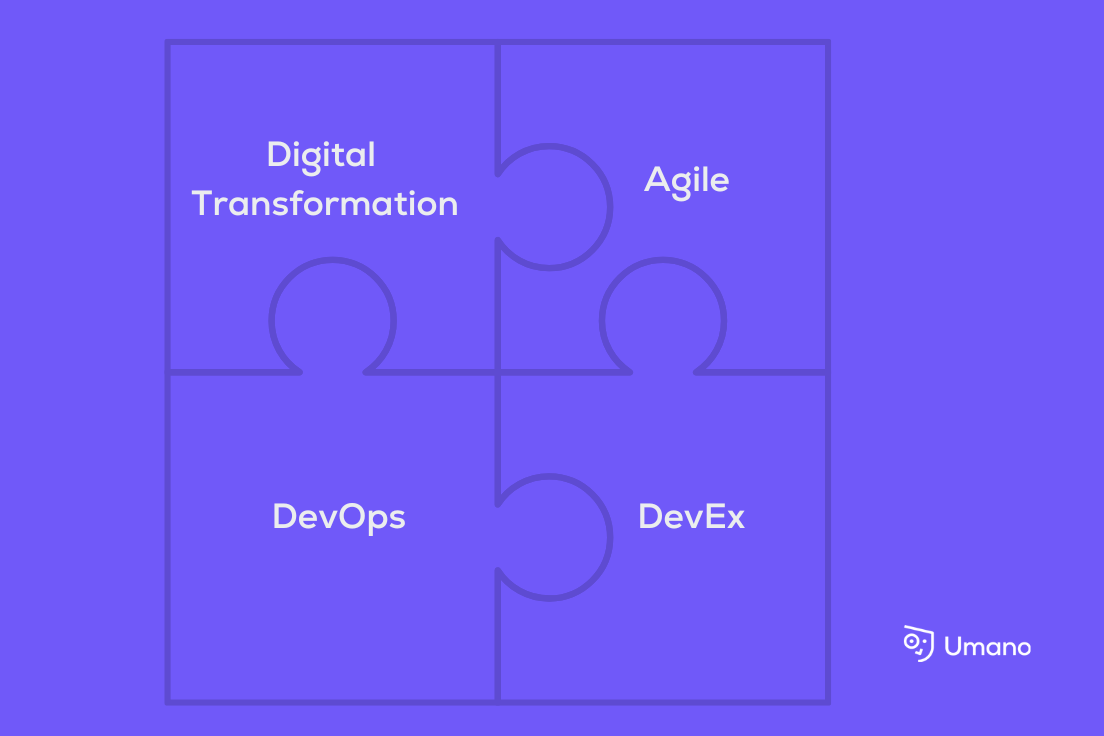When speaking with prospective customers about their broader context of why they want to measure their team's performance and embed data-inspired ways of working, we hear LOTs of different drivers, along with some quite different definitions of what these drivers mean to their organisation.
The main drivers for wanting to empower teams with data-inspired ways of working include:
1.accelerating a company's digital transformation and;
2. building stronger agile ways of working as a driver to achieve their transformation sooner.
Interestingly though, we hear different definitions of what these drivers mean for companies.
For us at Umano, we clearly separate digital transformation and agile ways of working, showing how they complement but don’t replace each other.
1. Digital Transformation (DT)
- What it is: A strategic shift in how a company leverages technology to improve operations, customer experience, and business models.
- Scope: Broad, often involving new digital tools, cloud adoption, AI, automation, and data-driven decision-making.
- Goal: Long-term business evolution to stay competitive in a digital world.
- Example: A traditional bank launching a mobile-only service to compete with fintech startups.
2. Agile Ways of Working
- What it is: A methodology focused on flexibility, collaboration, and iterative development.
- Scope: Primarily impacts teams, workflows, and organizational culture rather than the entire business model.
- Goal: Faster innovation, quick adaptation to change, and continuous improvement.
- Example: A software team using Scrum or Kanban to deliver features in short sprints instead of following a rigid roadmap.
How They Relate
- Agile is a tool for digital transformation: Digital transformation often requires a cultural shift, and agile helps teams adapt faster.
- DT is strategic, Agile is operational: A company can pursue digital transformation without being agile, but it risks failure if teams can’t adjust quickly.
- Agile is bottom-up, DT is top-down: Agile improves efficiency at the team level, while DT requires executive vision and investment.
How does DevOps and DevEx fit in here?
Modern organisations are more nuanced though. They also adopt DevOps prcatices and are increasingly thinking about engineering performance through the lens of DevEx (Developer Experience). DevOps and DevEx play crucial roles in both digital transformation and agile ways of working, but at different levels. Here’s how they fit in:
1. DevOps: Bridging Agile and Digital Transformation
- What it is: A set of practices that integrate software development (Dev) and IT operations (Ops) to shorten development cycles, improve quality, and automate deployment.
- How it connects:
- Supports Agile: Enables continuous integration and continuous deployment (CI/CD), making Agile iterations faster and smoother.
- Drives Digital Transformation: Helps organizations modernize their IT infrastructure, move to the cloud, and scale software delivery.
- Example: A retail company adopting cloud-based DevOps pipelines to push updates to their e-commerce platform daily instead of once per quarter.
2. DevEx: The Human Side of DevOps and Agile
- What it is: The overall experience of developers working within a company, including their tools, workflows, and processes.
- How it connects:
- Enhances Agile: Improves efficiency and reduces friction for developers, enabling them to ship code faster and with fewer frustrations.
- Supports Digital Transformation: A great DevEx makes it easier for teams to adopt new technologies, automation, and cloud-native approaches.
- Example: A company invests in better developer tooling (e.g., self-service infrastructure, automated testing, improved onboarding, metric and insights intelligence) to reduce cognitive load and increase productivity.
How They All Fit Together
- Digital Transformation sets the vision (e.g., "We need to become a cloud-first company").
- Agile enables faster execution of that vision (e.g., "We’ll use Scrum to iterate on our cloud migration strategy").
- DevOps provides the automation and technical foundation (e.g., "CI/CD pipelines will allow teams to deploy cloud-native apps seamlessly").
- DevEx ensures developers can work efficiently (e.g., "We’ll invest in better tools and reduce blockers so developers can focus on delivering value").
